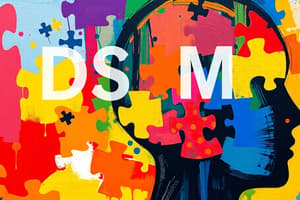Podcast
Questions and Answers
Which of the following is NOT a condition that was previously included under the category of ASD in earlier classification systems but is no longer considered a separate diagnosis in DSM-5?
Which of the following is NOT a condition that was previously included under the category of ASD in earlier classification systems but is no longer considered a separate diagnosis in DSM-5?
- Rett's Disorder
- Attention Deficit Hyperactivity Disorder (ADHD) (correct)
- Asperger's Disorder
- Autistic Disorder
According to the DSM-5 diagnostic criteria for ASD, what are the two core areas of impairment?
According to the DSM-5 diagnostic criteria for ASD, what are the two core areas of impairment?
- Challenges in academic performance and adaptive functioning
- Difficulties with sensory processing and emotional regulation
- Impairment in reciprocal social communication/interaction and restricted, repetitive behaviors (correct)
- Deficits in cognitive processing and motor skills
An individual with ASD is described as 'Level 2, Requiring substantial support.' What does this level indicate about the individual's impairments?
An individual with ASD is described as 'Level 2, Requiring substantial support.' What does this level indicate about the individual's impairments?
- The individual needs minimal support in social communication and repetitive behaviors.
- The individual needs constant, pervasive support in all areas due to severe impairments.
- The individual needs significant support to address impairments in social communication and repetitive behaviors. (correct)
- The individual needs a moderate amount of support to function in daily life.
Which factor does NOT contribute to the increased prevalence of ASD diagnoses over the past 30 years?
Which factor does NOT contribute to the increased prevalence of ASD diagnoses over the past 30 years?
Which of the following statements is true regarding associated features of ASD?
Which of the following statements is true regarding associated features of ASD?
How do sleep problems potentially exacerbate challenges for individuals with ASD?
How do sleep problems potentially exacerbate challenges for individuals with ASD?
What percentage of children with ASD displays at least some inappropriate mealtime behavior?
What percentage of children with ASD displays at least some inappropriate mealtime behavior?
What is food selectivity, a common feeding problem in individuals with ASD, primarily attributed to?
What is food selectivity, a common feeding problem in individuals with ASD, primarily attributed to?
What components are included in the intensive behavioral treatment package developed by Azrin and Foxx (1971) for toilet training adults with developmental disabilities?
What components are included in the intensive behavioral treatment package developed by Azrin and Foxx (1971) for toilet training adults with developmental disabilities?
Why have researchers raised concerns regarding the use of punishment procedures in toileting treatments for individuals with developmental disabilities?
Why have researchers raised concerns regarding the use of punishment procedures in toileting treatments for individuals with developmental disabilities?
What did Greer, Neidert, and Dozier's (2015) research on toilet training find regarding the use of underwear compared to diapers or pull-ups?
What did Greer, Neidert, and Dozier's (2015) research on toilet training find regarding the use of underwear compared to diapers or pull-ups?
What is a water-prompting procedure, as used by Hagopian, Fisher, Piazza, and Wierzbicki (1993), designed to treat in the context of toilet training?
What is a water-prompting procedure, as used by Hagopian, Fisher, Piazza, and Wierzbicki (1993), designed to treat in the context of toilet training?
Which of the following is NOT classified as a severe problem behavior commonly observed in individuals with ASD?
Which of the following is NOT classified as a severe problem behavior commonly observed in individuals with ASD?
What is the primary purpose of using functional-analysis procedures when addressing severe problem behavior in individuals with developmental disabilities?
What is the primary purpose of using functional-analysis procedures when addressing severe problem behavior in individuals with developmental disabilities?
Approximately what percentage of individuals with ASD are also diagnosed with epilepsy?
Approximately what percentage of individuals with ASD are also diagnosed with epilepsy?
What is the primary goal of Early Intensive Behavioral Intervention (EIBI) for children with ASD?
What is the primary goal of Early Intensive Behavioral Intervention (EIBI) for children with ASD?
Which principles of operant conditioning are commonly used in EIBI programs to increase adaptive behavior and reduce problem behavior?
Which principles of operant conditioning are commonly used in EIBI programs to increase adaptive behavior and reduce problem behavior?
How many hours per week do EIBI programs typically last?
How many hours per week do EIBI programs typically last?
According to the UCLA Young Autism Project outcome study, approximately what percentage of children with ASD receiving EIBI demonstrated substantial improvements?
According to the UCLA Young Autism Project outcome study, approximately what percentage of children with ASD receiving EIBI demonstrated substantial improvements?
According to research, what characteristics of EIBI programs are associated with better outcomes for children with ASD?
According to research, what characteristics of EIBI programs are associated with better outcomes for children with ASD?
According to the National Standards Project, which treatment approach is identified as an established intervention for children with ASD?
According to the National Standards Project, which treatment approach is identified as an established intervention for children with ASD?
What are the key features of Natural Environment Training?
What are the key features of Natural Environment Training?
What is the role of preference assessments in Natural Environment Training?
What is the role of preference assessments in Natural Environment Training?
What is a primary goal of incidental teaching?
What is a primary goal of incidental teaching?
What is a key feature of the Natural Language Paradigm?
What is a key feature of the Natural Language Paradigm?
What procedure is often used to promote spontaneous language in Natural Language Paradigm?
What procedure is often used to promote spontaneous language in Natural Language Paradigm?
What is a central focus of Pivotal Response Training?
What is a central focus of Pivotal Response Training?
What is the initial focus of treatment in the applied-verbal behavior approach to early intervention for ASD?
What is the initial focus of treatment in the applied-verbal behavior approach to early intervention for ASD?
What is a key component of discrete-trial training?
What is a key component of discrete-trial training?
Flashcards
Autism Spectrum Disorder (ASD)
Autism Spectrum Disorder (ASD)
A neurodevelopmental disorder evident in early childhood, characterized by impairments in social communication and interaction, and restricted, repetitive behaviors or interests.
Social Communication Impairment
Social Communication Impairment
Difficulties in reciprocal social interactions and communication, may involve reduced emotional reciprocity, odd speech patterns and delayed language skills.
Abnormal Behavior Patterns
Abnormal Behavior Patterns
Restricted, repetitive, or stereotyped interests or activities, such as repetitive actions or fixations on certain objects or routines.
Early Intensive Behavioral Intervention (EIBI)
Early Intensive Behavioral Intervention (EIBI)
Signup and view all the flashcards
Natural Environment Training
Natural Environment Training
Signup and view all the flashcards
Incidental Teaching
Incidental Teaching
Signup and view all the flashcards
Natural Language Paradigm
Natural Language Paradigm
Signup and view all the flashcards
Pivotal Response Training
Pivotal Response Training
Signup and view all the flashcards
Applied Verbal Behavior
Applied Verbal Behavior
Signup and view all the flashcards
Discrete-Trial Training
Discrete-Trial Training
Signup and view all the flashcards
Reinforcing Stimuli
Reinforcing Stimuli
Signup and view all the flashcards
Formal Skill Assessments
Formal Skill Assessments
Signup and view all the flashcards
Assessment-Based Instruction
Assessment-Based Instruction
Signup and view all the flashcards
Effective Strategies
Effective Strategies
Signup and view all the flashcards
Prompt Fading
Prompt Fading
Signup and view all the flashcards
Maintenance and Generalization
Maintenance and Generalization
Signup and view all the flashcards
Training Sufficient Exemplars
Training Sufficient Exemplars
Signup and view all the flashcards
Treatment Integrity
Treatment Integrity
Signup and view all the flashcards
Study Notes
- Autism spectrum disorder (ASD) is a neurodevelopmental disorder evident in early childhood.
- Standard classification systems previously included:
- Autistic disorder
- Asperger's disorder
- Rett's disorder
- Childhood disintegrative disorder
- Pervasive developmental disorder not otherwise specified
- Clinicians diagnose ASD based on criteria from the DSM-5.
- The DSM-5 no longer includes differential diagnoses like Asperger's or pervasive developmental disorder not otherwise specified.
- ASD is characterized by two core impairment areas
- Impairment in reciprocal social communication and social interaction
- Abnormalities in behavior patterns, characterized by restricted, repetitive, or stereotyped interests or activities.
- Difficulties in social communication include
- Social and emotional reciprocity
- Reduced affect
- Unresponsiveness to social interactions
- Odd and repetitive speech patterns
- Delayed speech and language skills
- Complete lack of spoken language
- Individuals with ASD may have difficulties with eye contact, peer relationships, and play skills.
- Abnormal behavior patterns consist of
- Repetitive behavior
- Stereotyped body movements
- Restricted activities
- Resistance to environmental changes
- Individuals may display hyper- or hyporeactivity to sensory stimulation.
- Clinicians specify ASD severity at three levels:
- Level 1: Requiring support
- Level 2: Requiring substantial support
- Level 3: Requiring very substantial support
- Severity is based on impairment in social communication/interaction and restricted, repetitive behaviors.
- Over the past 30 years, the prevalence of ASD has increased.
- Recent estimates indicate that ASD occurs in 1 in 54 children.
Associated Features of ASD
- Several medical conditions and behavioral excesses/deficits correlate with ASD.
- Associated features are not part of ASD diagnostic criteria.
- Include sleeping and feeding disorders, delays in toilet training, severe behavior problems, and genetic and medical conditions.
Sleep Problems
- Individuals with ASD display a higher incidence of sleep problems, including
- Increased daytime sleep
- Decreased total sleep
- Bedtime tantrums
- Frequent night wakings
- Sleep problems can cause:
- Decreased cognitive functioning
- Increased self-injurious and severe problem behavior
- Increased parental stress
Feeding Disorders
- Individuals diagnosed with ASD have substantially higher feeding disorders than typically developing children
- Up to 90% display inappropriate mealtime behavior.
- Common feeding problem: food selectivity, perhaps due to rigid and restricted interests.
- Children may not meet daily nutritional needs due to limited consumption of foods high in macro- and micronutrients.
- ABA-based treatments prove effective in increasing the variety of foods consumed and decreasing inappropriate mealtime behavior.
Delayed Toilet Training
- Many developmentally disabled individuals do not finish toilet training before age 6.
- Over half of parents with ASD children report concerns regarding toilet training and incontinence.
- Azrin and Foxx (1971) created an intensive behavioral treatment package for adults with developmental disabilities, including:
- Reinforcement for voids on the toilet, fluid loading
- Scheduled toilet trips
- Overcorrection
- Variations of this package have been evaluated in studies
Severe Problem Behavior
- Individuals are likely to engage in
- Self-injurious
- Aggressive
- Disruptive behavior
- Noncompliance
- Elopement
- Pica
- Researchers identify environmental variables that maintain problem behavior using functional-analysis procedures.
- Results inform treatment.
Associated Conditions and Genetic Disorders
- Individuals may have some level of intellectual impairment; estimates range from 18% to 70%.
- Medical conditions and genetic syndromes are more common.
- About 16% are diagnosed with epilepsy, with onset during childhood or adolescence.
- Genetic disorders, including tuberous sclerosis and fragile X syndrome, are also associated with ASD.
EARLY INTENSIVE BEHAVIORAL INTERVENTION
- EIBI is a comprehensive treatment approach for children
- Includes a comprehensive, hierarchically arranged curriculum implemented for several years
- Goal is to improve a child's overall functioning
- Procedures are developed based on operant conditioning principles, such as:
- Reinforcement
- Stimulus control
- Generalization
- Designed to increase adaptive behavior and reduce problem behavior
- EIBI therapist provides learning opportunities using programmed instructional and reinforcement procedures.
- Program targets multiple functions in a developmental sequence, improving broad skill areas.
- Educational targets include:
- Preacademic and academic skills
- Verbal behavior
- Social skills
- Independent-play skills
- EIBI programs last 2-3 years for 25-40 hours per week
- Includes individualized instruction in settings such as home, community and school
- Surveys show EIBI is one of the most common and requested treatments
UCLA Young Autism Project
- Landmark outcome study that documented improvements in about 47% of children receiving EIBI.
- Gains in functioning were maintained into adolescence.
- Success led to additional research and dissemination.
- EIBI is the most studied comprehensive treatment model for young children.
- Research compares
- Different intensities of EIBI
- EIBI and other treatments
- Clinic- versus caregiver-managed models
- Researchers have established criteria to review empirical support for EIBI in experimental studies (experimental rigor, verification of diagnosis, and measures of procedural integrity).
- Meta-analyses have sought to identify variables predicting behavioral intervention outcomes.
- Research on IQ at the start of treatment and whether the child benefits from EIBI has produced mixed or negligible results.
- EIBI programs with better outcomes (higher IQ scores, improved adaptive behavior, increased language skills) include:
- Greater treatment intensity
- Longer treatment duration
- Caregiver training
- Supervisor training with the UCLA model
- Results of meta-analyses and systematic reviews show EIBI is effective for many behavioral deficits and excesses
- National Standards Project identified it as an "established intervention"
- An established intervention has enough evidence to permit determination that the intervention produces positive outcomes
- EIBI has the most empirical support of all comprehensive treatment models.
ABA-Based Models of Early Intervention
- Developed to improve outcomes for children
- Models below have demonstrated effectiveness in studies and authors have published treatment manuals- review each model and describe key differences- and recommendations to improve learning
Natural Environment Training
- Emphasis on child-directed interactions
- Techniques that increase motivation to respond
- Generalization of skills
- Conducted in settings such as home, with caregivers trained to promote learning opportunities during playtime
- Capitalizes on naturally occurring establishing operations to teach functional-language skills
- Incorporates choice-making opportunities, frequent preference assessments
- Reinforcer variation across trials
- Intersperses mastered tasks to maintain motivation
- Programs training in free-play-like settings
- Decreases the similarity between the training setting and typical academic settings
- Typically targets requests for items in the initial portion of treatment to establish a functional relation between the vocal response and associated reinforcers
- Recommendations made by Stokes and Baer (1977) to promote training
- Training multiple exemplars
- Training across settings and therapists.
- Using intermittent contingencies generalization
Incidental Teaching
- Developed from experiences teaching language to preschool children in natural settings
- Conducted in unstructured settings such as free-play time
- Child-directed
- A therapist uses a child's initiation as a learning opportunity
- Teaches child to respond to multiple cues in the natural environment with spontaneous language
- Programs incorporate discriminative stimuli that signal the availability of adult attention for language attempts
- Therapist initiates learning trial when child shows interest in an item by pointing or gesturing to it.
- The therapist physically approaches the child
- Engages in eye contact
- Exhibits a questioning look
- Prompts if the child does not emit a spontaneous vocalization
- Fades prompts as the child responds accurately after less intrusive prompts
- Recommends rotating among a few prompts that are context-specific
- Limiting prompt variety ensures that the prompt functions as a discriminative stimulus for the vocal response.
- Previous research showed:
- Effectiveness in producing variability in verbal responses
- Generalization to novel therapists
- Preference for play activities that incorporated incidental teaching
- Research on children with ASD indicated:
- Training produces generalization of language
- McGee, Krantz, and McClannahan (1985)
- Compared incidental-teaching and traditional-teaching procedures
- Noted the acquisition of target prepositions did not vary across teaching procedures
- Incidental-teaching sessions were longer than traditional-teaching sessions
- Conclusion: need additional research comparing teaching to identify procedures that produce:
- Rapid acquisition
- Levels of attending
- Generalization of skills across settings and therapists
- The least amount of instructional time necessary to produce mastery of target skills
- Additional need to identify child preferences for language-training strategies
Natural Language Paradigm
- Developed as both training and play, to create learning
- Provides child with choices between high-preference stimuli
- Learning Begins- child selects a preferred item
- Access is restricted, models short phrase, motor activity, uses shaping reinforce closer approximations across trials.
- Provides short access to the preferred item & pair it with Reinforcement & play
- Repeat the vocalization during reinforcement
- Removes item, models diff. phrases
- Repeats initial steps
- Goal to prevent and maintain response driving force
- Uses graduated delay to spur on spontaneous language
- Training- involves repeating rounds toy sharing,
- Facilitates expansion- multiple replies stimuli
- Research on the natural language paradigm shows skills speed & expansion across different arenas
Pivotal-Response Training
- Focuses on pivotal areas: skills that boost improvement in other areas.
- Intervention transpires naturally- child's house etc
- Exploits naturally arriving environmental stimulus such model vocally and actioning when child mirrors
- Promotes Care givers & educators to adopt across different settings for training
Applied-Verbal Behavior
- The applied-verbal behavior approach to early intervention for ASD is based on Skinner's (1957) functional approach to verbal behavior.
- Functional approach defines a verbal operant based on:
- Topographical characteristics
- Antecedent events
- Consequent events
- Skinner's (1957) taxonomy includes seven elementary verbal operants
- Early intervention programs typically focus on five of these:
- Mand
- Tact
- Echoic
- Intraverbal
- Autoclitic
- Treatment typically begins with mand training for benefit to the speaker
- A mand is a verbal operant that a relevant establishing operation evokes the delivery and requested consequence reinforces
- Behavior analysts should conduct mand training by using the appropriate antecedent and consequent events.
- Effective when:
- Relevant establishing operations are present or presumed to be present
- Consequence related to the child's mand is available
Discrete-Trial Training
- Developed behavioral means children ASD
- High structured methodology table to educate, parts to teach etc. Each segments mastered then merged in behavior order
- Top selections supplied upon good answers
- Quick skill getting because it permits more trials & opportunities
Unique Features of Early-Intervention Models
- All behavioral based versions adopt techniques
- Both emphasize naturalistic education requests & conditions where childs keen to obtain the item
- Skills differ from training
- Requires explicit, verbal stimuli e.g what it's called as opposed conditioning with trials under management, natural etc
Combining Early-Intervention Models
- Each model brings unique strength for treatment
- Therapist might mix techniques to aid function, stimuli etc with training
CLINICAL CONSIDERATIONS AND FUTURE RESEARCH
- Reinforcement and the setting and climate are great key in impacting effectiveness
- Analysts do various tests identify hierarchy reinforcing for each candidate
- Intersperse the opportunity & support selecting
Assessing and Identifying Target Skills
- Behavior analyst must analyze candidates present ability stage, several areas, choose the stage to enter & improve
- The formal evaluations support measuring conduct etc at the start & during the whole teaching process
Instructional Procedures
- Better improving on methodologies and success especially tailored those with ASD/learning
- The use checks in place give the best, greatest benefit
Identifying Effective Prompting Strategies
- Check, then promote the individual
- The use and the setting
Maintenance and Generalization
- Prime motive is child demonstrating before taught in setting, conditions etc
- In circumstances models miss generalising or support
Treatment Integrity
- Numerous trials show positive connection
- A few show various elements hurt progress and overall outcomes
Studying That Suits You
Use AI to generate personalized quizzes and flashcards to suit your learning preferences.




